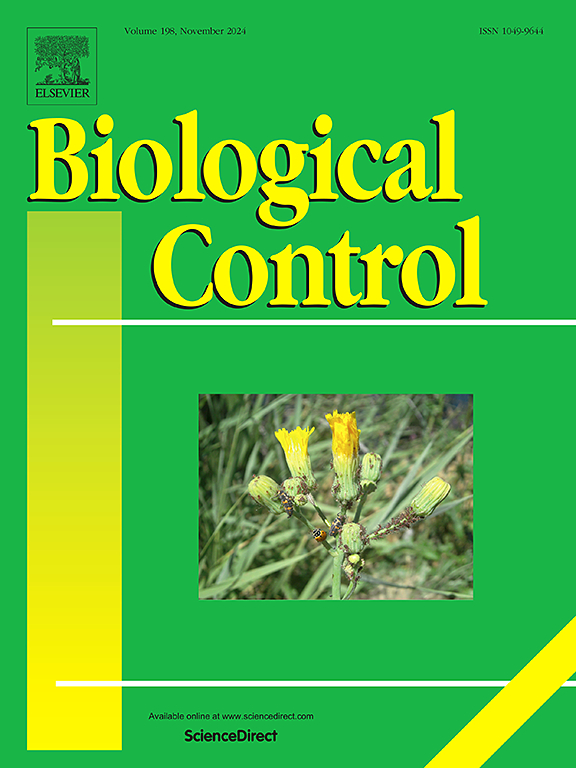Enterococcus mundtii (JBC60 isolate) in the control of the fall armyworm: A new biocontrol possibility
IF 3.7
2区 农林科学
Q2 BIOTECHNOLOGY & APPLIED MICROBIOLOGY
引用次数: 0
Abstract
Productivity losses caused by pests and diseases result in economic damage worldwide. Despite the effectiveness of chemical control, these methods pose risks to the environment and human health, and their continued use can lead to the development of resistance in pests and pathogens. As a result, biological alternatives have gained prominence in the market, although the number of bacterial-based biological agents remains limited. This study aimed to prospect new bacterial isolates with potential to control insect pests, obtained through the insect-trapping method. Bacteria were isolated from dead larvae, and their insecticidal activity was evaluated. The genus identification and species approximation were performed through 16S rRNA barcoding sequencing, along with the characterization of the bacterial growth curve and its insecticidal activity over seven days. A total of 70 isolates were obtained, of which 10 inhibited the growth of Spodoptera frugiperda. The sequencing analysis identified these isolates as Enterococcus mundtii, Enterococcus gallinarum, Enterococcus casseliflavus, and Serratia nematodiphila. Among the active isolates, five showed a growth inhibition rate higher than 90 %, including E. mundtii, E. gallinarum, and E. casseliflavus. For further studies, the JBC60 isolate of E. mundtii was selected due to its high activity and its non-pathogenic nature to humans. The growth curve showed maximum growth at 12 h of cultivation (3.17 × 108 CFU/mL) and a maximum OD of 0.7214 at 6 h. The insecticidal activity demonstrated a growth inhibition rate above 90 %. Our results indicate that E. mundtii (JBC60) has high potential to become a biological control agent against Spodoptera frugiperda.

蒙氏肠球菌(JBC60分离株)防治秋粘虫:一种新的生物防治可能性
病虫害造成的生产力损失在世界范围内造成经济损失。尽管化学防治有效,但这些方法对环境和人类健康构成风险,继续使用这些方法可能导致害虫和病原体产生抗药性。因此,尽管基于细菌的生物制剂的数量仍然有限,但生物替代品已经在市场上获得了突出地位。本研究旨在寻找利用捕虫法获得的具有防治害虫潜力的新分离菌。从死亡的幼虫中分离细菌,并对其杀虫活性进行了评价。通过16S rRNA条形码测序进行属鉴定和种近似,并对菌株生长曲线和7 d杀虫活性进行表征。共分离得到70株菌株,其中10株菌株对夜蛾生长有抑制作用。测序分析鉴定这些分离物为蒙地肠球菌、鸡状肠球菌、casseliflavus肠球菌和嗜线虫沙雷菌。活性菌株中,有5株生长抑制率大于90%,分别为蒙地大肠杆菌、鸡大肠杆菌和casseliflavus。为了进一步的研究,我们选择了蒙地伊氏杆菌的JBC60分离株,因为它具有高活性和对人类的非致病性。生长曲线显示,菌株在培养12 h时最大生长(3.17 × 108 CFU/mL), 6 h时最大OD值为0.7214,杀虫活性抑制率在90%以上。结果表明,蒙氏夜蛾(JBC60)具有很强的生物防治潜力。
本文章由计算机程序翻译,如有差异,请以英文原文为准。
求助全文
约1分钟内获得全文
求助全文
来源期刊

Biological Control
生物-昆虫学
CiteScore
7.40
自引率
7.10%
发文量
220
审稿时长
63 days
期刊介绍:
Biological control is an environmentally sound and effective means of reducing or mitigating pests and pest effects through the use of natural enemies. The aim of Biological Control is to promote this science and technology through publication of original research articles and reviews of research and theory. The journal devotes a section to reports on biotechnologies dealing with the elucidation and use of genes or gene products for the enhancement of biological control agents.
The journal encompasses biological control of viral, microbial, nematode, insect, mite, weed, and vertebrate pests in agriculture, aquatic, forest, natural resource, stored product, and urban environments. Biological control of arthropod pests of human and domestic animals is also included. Ecological, molecular, and biotechnological approaches to the understanding of biological control are welcome.
 求助内容:
求助内容: 应助结果提醒方式:
应助结果提醒方式:


